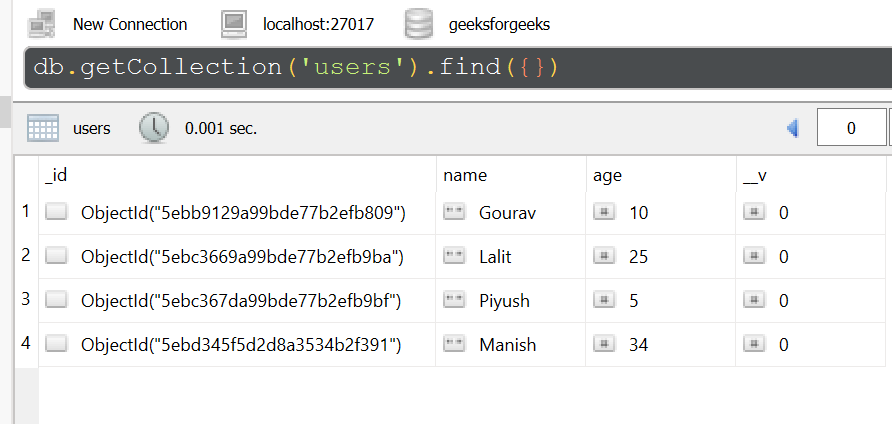How does Query.prototype.map() works in Mongoose ?
Last Updated :
31 Jul, 2021
The Query.prototype.map() function is used to run a function fn and treats the return value of fn as the new value for the query to resolve to. All the function which are passed to map() function will be run after any post hooks.
Syntax:
Query.prototype.map()
Parameters: This function has one parameter fn which is function to run to transform the query result.
Return Value: This function returns Query Object.
Mongoose Installation:
npm install mongoose
After installing the mongoose module, you can check your mongoose version in command prompt using the command.
npm mongoose --version
After that, you can just create a folder and add a file for example, index.js as shown below.
Database: The sample database used here is shown below:

Example 1:
Here, the filename is index.js
Javascript
const mongoose = require('mongoose');
useNewUrlParser: true,
useCreateIndex: true,
useUnifiedTopology: true
});
const User = mongoose.model('User', {
name: { type: String },
age: { type: Number }
});
const query = User.find({name:"Lalit"}).map(res => {
console.log("loadedAt property set on the doc "
+ "to tell the time doc was loaded.")
return res == null ? res : Object.assign(res,
{ loadedAt: new Date() });
});
query.exec(function(err, res){
if(err) console.log(err)
else console.log(res)
});
|
The project structure will look like this:

Run index.js file using below command:
node index.js
Output:
loadedAt property set on the doc to tell the time doc was loaded.
[
{ _id: 5ebc3669a99bde77b2efb9ba, name: 'Lalit', age: 25, __v: 0 },
loadedAt: 2020-07-14T18:22:57.991Z
]
Example 2:
Here, the filename is index.js
Javascript
const express = require('express');
const mongoose = require('mongoose');
const app = express()
useNewUrlParser: true,
useCreateIndex: true,
useUnifiedTopology: true
});
const User = mongoose.model('User', {
name: { type: String },
age: { type: Number }
});
const query = User.find().map(res => {
console.log("loadedAt property set on the doc "
+ "to tell the time doc was loaded.")
return res == null ? res : Object.assign(res,
{ loadedAt: new Date() });
});
query.exec(function(err, res){
if(err) console.log(err)
else console.log(res)
});
app.listen(3000, function(error ) {
if(error) console.log(error)
console.log("Server listening on PORT 3000")
});
|
The project structure will look like this:

Run index.js file using below command:
node index.js
Output:
Server listening on PORT 3000
Server listening on PORT 3000
loadedAt property set on the doc to tell the time doc was loaded.
[
{ _id: 5ebb9129a99bde77b2efb809, name: 'Gourav', age: 10, __v: 0 },
{ _id: 5ebc3669a99bde77b2efb9ba, name: 'Lalit', age: 25, __v: 0 },
{ _id: 5ebc367da99bde77b2efb9bf, name: 'Piyush', age: 5, __v: 0 },
{ _id: 5ebd345f5d2d8a3534b2f391, name: 'Manish', age: 34, __v: 0 },
loadedAt: 2020-07-14T18:24:36.890Z
]
Reference: https://mongoosejs.com/docs/api/query.html#query_Query-map
Share your thoughts in the comments
Please Login to comment...